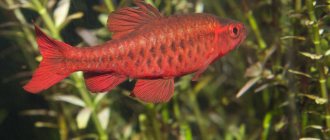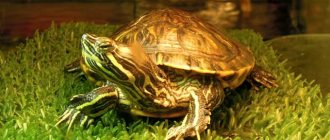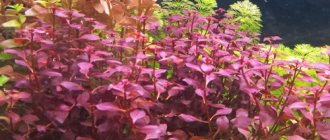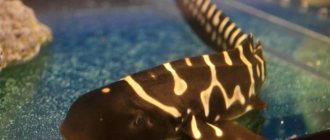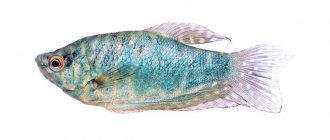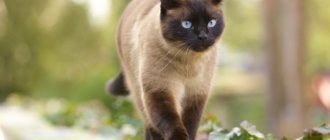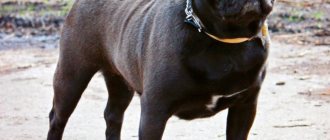One of the most colorful aquarium fish is the turquoise acara. With its impressive variegated colors and aggressive disposition, it is the most popular member of the cichlid fish family. In the natural environment, this population can be found in the warm territorial waters of such southern African countries as Ecuador and Peru.
Acara is not very fond of clean fresh water, so the fish try to settle in the mouths of rivers, where ocean water flows with a characteristically high acid-base balance.
Often inexperienced aquarists confuse the turquoise acara with the bluish-spotted one . Indeed, these fish have certain similarities, and were even considered one species for a long time. Turquoise acara has larger dimensions, reaching up to 30 cm at maturity in natural conditions, but the aquarium environment rarely allows the fish to grow more than 15 cm. Much depends on the existing aquarium; the more spacious it is, the larger the individual will be.
their name in honor of the unique blue-green shine of their scales , shimmering in different shades in the light. The dorsal and caudal fins, which have a beautiful bright orange edging, are attached to the strong, high body of the acara. Most of the snout and gills are covered with sinuous turquoise stripes.
Males are usually larger and more brightly colored than females. With age, a fatty growth forms on the forehead of the male, and a sharp point appears on the anal fin.
In cichlids of other species, males occupy a dominant position , while in cichlids, females are more temperamental and capable of pronounced aggression. In South America, turquoise fish are known as “green terrorists” due to their hot-tempered nature and quarrelsomeness with other river inhabitants. However, these are very smart fish. They are able to recognize their owner and swim with interest to the glass in order to evaluate the person.
Description and natural habitat
Acara turquoise is found in the territorial waters of Ecuador, South America and northwestern Peru.
It is a freshwater, solitary predator of large build, reaching a length of up to 30 cm in the natural environment, and up to 20 cm in the aquarium.
Males are larger and differ from females in their more variegated color, as well as the presence of a well-defined fat pad on the forehead. The color of the body ranges from silver to tones of blue and green. There are winding turquoise lines on the head, and a large black spot is located in the center of the body. The dorsal fin is sharp-shaped, the caudal fin is rounded. Both are edged with a fiery, gold or white stripe.
Photo gallery of Akara Biryuzova:
Prefer a quiet environment. Life expectancy is up to 10 years.
Appearance and features
Photo: Blue Acara
Acaras have a somewhat flattened, tall body that is elongated in length. The head of the fish is large, distinguished by a characteristic convex forehead. This structural feature is more pronounced in males who have a specific fatty growth on the forehead, which is present to one degree or another in all cichlids and manifests itself upon reaching maturity.
The eyes of turquoise cancers are large in relation to the overall size of the head. The structure of this organ allows fish to see well in the twilight of the underwater part of the reservoir, which is usually littered with branches and heavily overgrown with aquatic plants. Cancer's lips are large. In this part of the body, a large number of nerve cell endings are concentrated, which play the role of chemical receptors and give fish the opportunity to accurately find both food and partners, and determine the location of the school.
A characteristic feature of the body structure of turquoise cancers is a rounded caudal fin, as well as pointed anal and dorsal fins. Males have longer fins, often anal and pointed at the back. Body colors in cancer are diverse and depend on the species. The color shades are also varied - from reddish-burgundy to blue-blue. The color of males is always brighter than that of females.
The size of cancer is variable and specific to each type. The smallest are the maroni acaras, the females of which grow up to seven centimeters (the males are slightly larger), and the zebra acaras, which grow up to five centimeters. Representatives of bluish-spotted and turquoise cancers grow up to a quarter of a meter.
Mr. Tail Recommends: Aquarium Basics
Turquoise acara is a rather aggressive species of fish, especially females, which is why the condition for their comfortable keeping is the presence of sufficient personal space - aquariums with a volume of 100 liters per individual.
Landscaping of the tank must be done with non-living or unpretentious plants with strong rhizomes: echinodorus, Java fern, Java moss. Substrate: round stones of medium fraction (up to 10 mm in diameter).
For decoration they use driftwood, large flat stones, caves and other places where you can hide. They should be well secured to the bottom, since Turquoise acaras tend to rummage through the entire contents of the aquarium during reproduction.
Habitat indicators:
- temperature +23…+25 °C;
- acidity 6-8 pH, hardness 5-13 dGH;
- high-quality aeration, filtration;
- weekly water changes - at least 1/3 of the available volume;
- The lighting is average, daylight hours are up to 9 hours.
Care and maintenance of fish
Acaras became guests of aquariums relatively recently - only in the 70s of the last century. For many, these fish cause indescribable delight, and their low cost attracts beginners. However, their capricious nature and grooming characteristics are such that they are not suitable for beginners.
Turquoise acara will only be comfortable in a large aquarium - at least 300 liters. Space allows Pisces to splash out their energy and overcome aggressiveness.
Since in nature acars love secluded places in which to hide, the aquarium is equipped with driftwood and large stones. However, they should not have sharp edges that are dangerous for fish. Animals need good aeration and filtration, and about a quarter of the water in the aquarium must be changed weekly.
In general, turquoise acara are unpretentious: they require no more attention and care than other types of fish. They will be satisfied with water of medium hardness and acidity, temperature 22-26 degrees. Acaras are able to survive short-term temperature drops of up to 18 degrees.
You should be careful with live aquarium plants: the activity of the fish is high, they constantly dig the soil. It is better to give preference to Anubias, Cryptocorynes and Echinoduras.
Red-breasted Acara
Compatibility
Turquoise akars are characterized by territorial and intraspecific hostility.
It is optimal to keep them in a species aquarium consisting of one pair. However, it is also possible to combine with other varieties of large sizes:
- catfish-like: synodontis, pterygoplichthus;
- cichlids: severum, astronotus, hybrid parrots;
- cichlazomas: black-striped, Nicaraguan;
- chromis;
- shark barb.
It is not recommended to keep with the following species:
- Manguan cichlazoma;
- red-headed cichlazoma;
- scalar;
- discus;
- viejoy;
- tilapia;
- neon;
- guppies, etc.
How to distinguish Andinoacara rivulatus from other species
This fish is similar to its close relative Andinoacara stalsbergi. This species was brought to the USSR in the 70s and received the name emerald acara, but the name did not stick.
Turquoise Acara (A. Rivulatus) grows slightly larger. The best way to tell the difference between the two varieties is to compare the color of the scales and fin trim. In A. Rivulatus, the scales have a light blue-green edge with a dark center, and the dorsal and caudal fins have a broad orange or white edge. The scales of A. stalsbergi are the opposite, with a dark blue to green center and dark edging, fins with a thin silver-white edge.
This species is also confused with its similar sister Blue Acara Aequidens pulcher. They are similar in some aspects, but there are key differences.
On the left is a bluish-spotted acara, on the right is a turquoise one.
The color of Blue Acara is primarily a steely blue-gray with less of a greenish sheen. Turquoise acara is larger, reaching a length of 25-31 cm, and Blue Acara grows to approximately 21 cm. Mature Andinoacara rivulatus develops a pronounced growth on the head, and Blue Acara has a flat forehead.
Feeding
Turquoise acara, being a carnivorous fish, can become almost omnivorous when grown at home, eating, in addition to plankton, crustaceans and worms (especially red earthworms), dry ready-made or home-made mixtures: finely chopped cod and squid meat. You can use frozen foods (krill, mosquito larvae, shrimp), as well as cereal and green vegetables (spinach, lettuce, cucumber, young peas).
Meat with a high protein content should not be given to avoid problems with the digestive system.
Feeding frequency: twice a day. It is recommended to do a deload once a week.
Natural enemies of turquoise cancers
Photo: Turquoise acara fish
Akaras are not of commercial interest for economic activity. The ease of breeding in captivity has caused a loss of interest in these fish from suppliers of aquarium fish to retail chains in America, Europe and Asia, and the low nutritional value does not arouse interest from companies involved in catching table fish species.
Thus, the circle of enemies of cancer is outlined by predators, for which these fish are natural food. Such enemies primarily include juvenile caimans, whose diet in the first periods of life is based on small fish and large insects. Animals such as the predatory Matamata turtle also successfully hunt the carp. Great damage to acar populations is also caused by herons of various species that hunt fish in shallow waters. Juveniles of such predatory fish as arapaima do not disdain akars.
Perhaps the main enemy of the cancer was such skilled hunters as the Brazilian otters. However, a significant reduction in the population of the latter due to human intervention in the nature of the Amazon has removed these predators from the list of the main enemies of cancer. At present, no animal has been identified that preys only primarily on carnivores. Therefore, it is impossible to talk about specific enemies of these fish.
Breeding
Turquoise cancers become capable of reproducing when they reach the age of 8 months.
To create a pair, it is desirable to form a temporary group of 4-8 unripe individuals. The female independently chooses a partner for the birth of offspring. It is not difficult to identify an established couple: being in constant contact, they will often rub against each other.
Before starting breeding, you should also create special conditions - adjust the water parameters: acidity pH 6.5, hardness 4-12 °dGH, temperature +25 °C. And also take care of the presence of flat stones, where the female will lay about 400 eggs, and the male will fertilize them. If adults try to eat eggs, you should immediately move the clutch to a separate tank, keeping the conditions of the aquatic environment the same as during spawning. Add antifungal and antimicrobial agents. Use tweezers to remove dead white eggs.
After 3-4 days, the larvae hatch, which the female transfers to previously prepared holes. After 5 days, they will become fry and begin to move freely around the aquarium. The diet includes cyclops, rotifers and ciliates. From a month - microplankton, artemia nauplii, crushed bloodworms, shrimp, flakes or other dry food. The growth of young animals is uneven: it accelerates over time.
As the size of the fish increases, larger food items are used.
Difficulty in content
Although this is a very beautiful fish that attracts the attention of aquarists, it cannot be recommended for beginners. This is a large and aggressive fish that requires a lot of free space to keep.
A pair of akaras can literally terrorize their neighbors and need to be kept with large and strong fish. In addition, they are very sensitive to water parameters and sudden changes.
Due to these circumstances, they can only be recommended to aquarists who already have experience in keeping large cichlids.
True, even a beginner can successfully keep them only if he can create suitable conditions and select large neighbors.
Diseases and prevention
Diseases of Turquoise Acara are most often provoked by a stressful condition associated with its unfriendly nature, or poor quality care: non-compliance with living conditions, overeating or the use of poor food as food, in particular infected worms.
If a sick individual is discovered, it is recommended to immediately isolate it, move it to another tank, and begin treatment. In the aquarium, it is necessary to completely replace the water and disinfect both the container itself and its contents.
Let's look at the most common diseases of Turquoise Acara.
Spironucleosis
Hexamitosis or octomitosis. Caused by a parasite. The reason is a violation of the feeding regime, including overfeeding with food with a high protein content, or excessive pollution of the environment.
Symptoms:
- decreased appetite and body weight;
- privacy;
- bloating;
- darkening of scales;
- frequent mucus discharge;
- destruction of fins;
- ulcers or abscesses on the head: characteristic of a more advanced form of the disease.
Metronidazole, Tetracycline, Furazolidone, Kanamycin are used.
Ascites
Abdominal dropsy. Reasons include: poor quality food, violation of living conditions, prolonged stress, old age.
Signs:
- bloated stomach;
- ruffled scales;
- bulging eyes;
- inactivity.
Can be fatal.
At an early stage, antibiotics are used: Oxytetracycline, Chloramphenicol or SERA Baktopur Direct, the dosages of which are determined by the size of the specimens, or Gentamicin - added daily to water - 20 mg per 1 liter.
Akara in nature
The historical homeland of cancer is considered to be reservoirs located in the northwestern part of Peru and the Rio Esmeraldas River basin. They are also found in South America, Central Colombia, Brazil and some other countries, preferring bodies of water without strong currents with rich vegetation and multiple shelters.
Cancers have been kept in aquariums since the seventies of the last century, and today they are one of the most sought-after cichlids among fish lovers.
Habitat
The turquoise acara is native to the Pacific part of South America: from the Tumbes River in Peru to the Esmiraldes River in Ecuador. The first scientific description of the turquoise acara was made by the British ichthyologist Albert Gothelf Gunther in 1860. The name of the genus “Akara” itself is translated as “stream”.
Acaras live in both clear and “dark” water saturated with humic substances.
To keep a turquoise acara, first of all, you need a spacious aquarium. It is better if the volume of water per pair of fish is at least 300 liters. To effectively purify water, it is necessary to use a high-performance external filter. It will not only allow you to collect various suspensions in the water, but also prevent an increase in the concentration of dangerous products of nitrogen metabolism in the aquarium, thanks to the activity of beneficial nitrifying bacteria. You should also install a powerful compressor, which will enrich the water with oxygen, which is necessary for fish and microorganisms to breathe.
The most suitable decorations for keeping cancer are sandy soil (or large pebbles), stones and natural driftwood. The lighting should not be very bright.
Turquoise acara in an aquarium
Optimal water parameters for keeping: T = 24-26°C, pH = 6.5 – 7.9, GH = 5-13.
Thus, the water needed is soft and slightly acidic/neutral, which is typical for many inhabitants of water bodies in South America.
Unfortunately, planting live plants in an aquarium with turquoise acaras, in most cases, will not be advisable, since the fish are constantly digging up the soil. If desired, you can use species with hard leaves, for example, anubias, which must be firmly secured to prevent floating to the surface.


